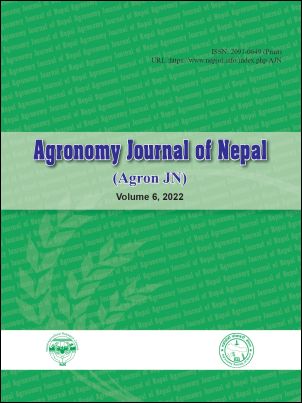Reasonable Fertilization Improves the Conservation Tillage Benefit for the Yield of Winter Maize in Rice-based Cropping System of Central Inner Terai of Nepal
DOI:
https://doi.org/10.3126/ajn.v6i1.47936Keywords:
Nutrient Expert, residue, rice-based system, conservation agriculture, wheatAbstract
To investigate the effects of fertilization, tillage, and their interaction on maize yield, an experiment on rice-maize was conducted on 2018/19 and 2019/20 at Agriculture and Forestry University (AFU), Rampur, Chitwan, Nepal. The experiment was in a split-plot with two establishment methods viz. (i) zero tillage followed after (fa) conventionally tilled dry direct seeded rice (ZT fa CT-DDSR) (ii) conventional tillage fa puddled transplanted rice (CT fa Pu-TPR) and four nutrient management practices, i.e. (i) recommended dose (100% RDF; 180-90-60 N-P2O5-K2O kg ha-1), (ii) Residue retention of rice crop @ 5 t ha-1 + 75% RDF (RR +75% RDF), (iii) Nutrient expert (NE) dose (150-50-90 N-P2O5-K2O kg ha-1), (iv) Rice residue @ 3.5 t ha-1 +75% RDF followed after brown/green manuring of Sesbania in rice (R+75% RDF fa BM/GM) and the treatments were replicated thrice. The data on yield and yield attributes were recorded and analyzed by R studio. Both crop establishment methods and nutrient management practices did not influence (p>0.05) the plant population, number of cobs per plant, number of grains per cob, thousand-grain weight, and sterility. The barrenness percentage was not significantly affected by the crop establishment methods but significantly (p>0.05) lower under residue retained treatments. Application of NE dose, sterility was significantly (p<0.05) reduced under ZT fa CT-DDSR. The average grain yield, straw yield, and harvest index (HI) were 6153 kg ha-1, 4547 kg ha-1, and 53.81% respectively. The two years average grain yield was statistically at par (p>0.05) for both crop establishment methods whereas application of NE dose, RR+75% RDF, and R+75% RDF fa BM/GM resulted in significantly (p<0.05) higher grain yield than obtained in the 100% RDF applied plots. Maize planting on zero tillage followed after CT-DDSR was equally productive and the use of a nutrient expert for nutrient recommendation or retention of residues with a 25% reduction of the RDF had a yield advantage over the present RDF.
Downloads
Downloads
Published
How to Cite
Issue
Section
License
Copyright (c) 2022 Agronomy Society of Nepal (ASoN)

This work is licensed under a Creative Commons Attribution-NonCommercial 4.0 International License.
ASON permits for free use, distribution and reproduction in any medium if the original work is properly cited and not used for commercial purposes.




